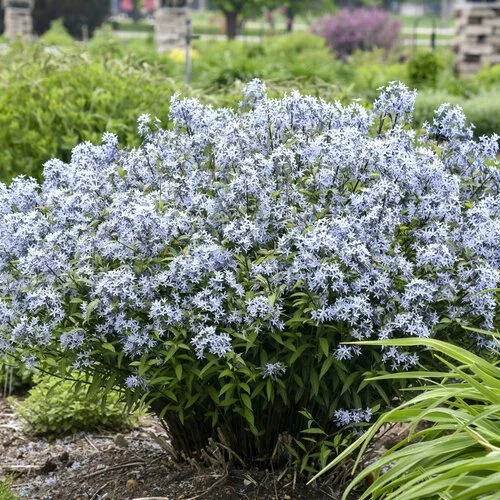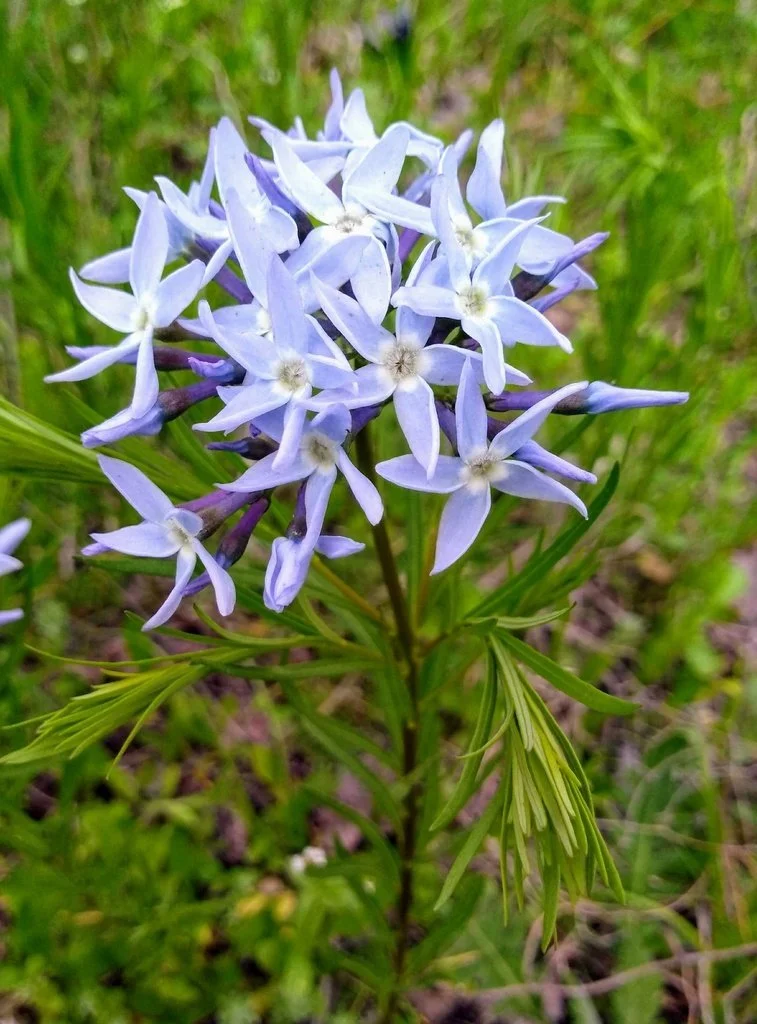Blue star (Amsonia tabernaemontana)
”Storm Cloud” Blue star (Amsonia tabernaemontana)
Monthly Theme: Twinkle, twinkle little blue star won’t you tell me what you are?
Blue star (Amsonia tabernaemontana) is a versatile herbaceous perennial named after the brilliant clusters of periwinkle blue star-like flowers. They produce 50-70 star-shaped flowers on each cluster. In Ohio, they bloom from late spring to early summer – best in June, but the plant is lovely throughout the growing season bringing interest to any garden landscape. In the fall, the leaves turn a golden yellow shade. These plants are native to North America and can be found in almost every state in the union.
I bought mine at a little independent garden center year and years ago. I found them out back in a clearance bin with lots of other dying plants. They cost me $1 each and I bought three unmarked plants. I babied them back to health and they have been growing beautifully for me ever since I rescued them from the trash heap! When I moved some 19-years ago, I brought two starters for my new house. They are planted on both sides of the apron or entrance to my driveway. Now they are about 3.5’ x 3.5’ and serve as a stunning entryway into to my yard.
Of all the plants I have growing in my yard (and trust me I have lots of plants), I get the most compliments for the blue stars. I’ve often had people stop their cars to ask me what type of plant was growing in my driveway. So, they truly are a true-blue show-stopper or at least a car-stopper!
Once these plants reach maturity, they look more like a flowering scrub than a perennial. The long stems gracefully sway and dance in the wind. They like to be planted next to another blue star – so buy at least two plants so they have a buddy!
In northeastern Ohio, the two most common amsonia species are Eastern blue star (Amsonia tabernaemontana) and Arkansas blue star (Amsonia hubrichtii). “Storm Cloud” blue star (Amsonia tabernaemontana) is the variety I have growing in my yard and it produces willowy or lance leaves. The Amsonia hubrichtii has feathery needle-like leaves. Both like full sun and do not require excellent soil. Honestly, they are quite a hardy plant once established. They are not heavy feeders so they do not require a lot of fertilizer.
If you don’t want them to go to seed, after plants are finished blooming, cut them back by 1/3. I don’t do this because I like the seeing the attractive bean-like seed pods.
You can start them from seed, but it will take a few years before they bloom if you go that route. It’s easier to get a starter plant or dig up a cluster from a friend (Amsonia don’t mind being divided). In late spring, plant deeper than you plant most of your perennials. Plant them at least three feet apart. They will die back in late fall/early winter and go dormant during the harsh winter months. Fear not – they will return in the spring in all their glory!
Some companion plants for Amsonia are: peony, bee balm, coneflowers, hydrangea, viburnum, Shasta daisy, anise hyssop or butterfly bushes. Basically, any plant who likes the same growing conditions.
Smarty Plants Fun Facts
Amsonia is in the Dogbane Family (Apocynaceae)
Loamy, clay, sandy or rocky well-drained soil (doesn’t want wet feet)
Soil 5.6 – 6.2 pH
Full sunlight, but can survive in partial sun
Blooms May-July
Can grow 3’ x 3’
Blue star close up view.
The More You Grow
Amsonia are in the same family as an oleander and milk weed. These plants all have a milky sap in their stems, which is toxic to dogs and unhealthy for small children.
On the other hand, because of this toxic sap, insects, pests, and pesty mammals (aka DEERS) stay away from this plant!
Amsonia was named in honor of a 18th-century physician Dr. Charles Amson from Virginia. As well as a 16th-century herbalist named Jakobus Theodorus Tabernaemontanus.
Native Americans used Amsonia to treat rattlesnake bites.
They work well as a cut-flower to decorate the inside of your home as well as the outside. The nectar of the common blue star is enjoyed by insects such as butterflies/moths, Carpenter Bees, and Ruby-throated Hummingbirds.
Some common names for this native plant include: Ozark blue star, Common blue star, Willow amsonia, Eastern blue star, Blue dogbane, and Woodland blue star. Also, I’ve seen it spelled as two words (blue star) or one word (bluestar).
In summation, if you are looking for a splash of blue color in your yard and have room for a large, adaptable, low-maintenance, hardy perennial, look no further than the native Blue Star.


